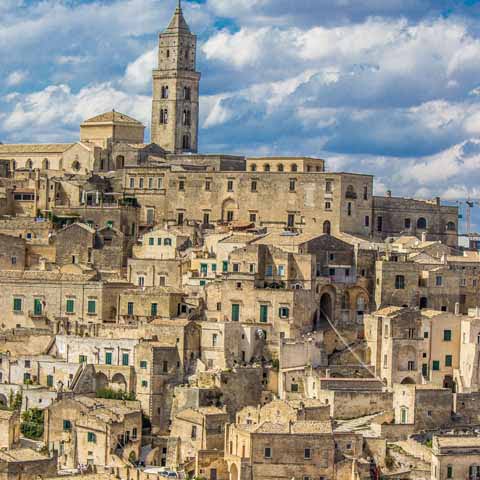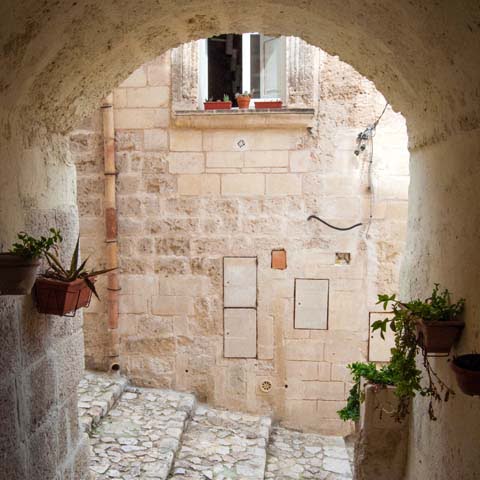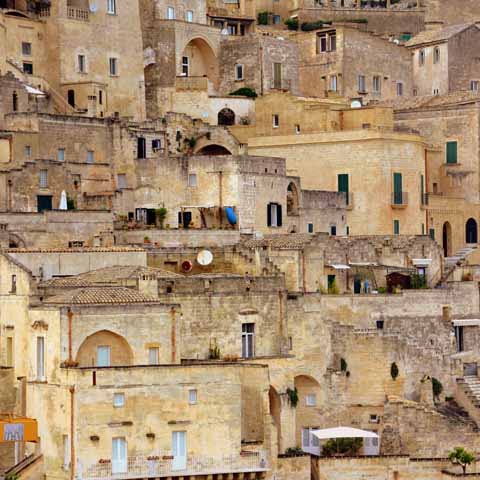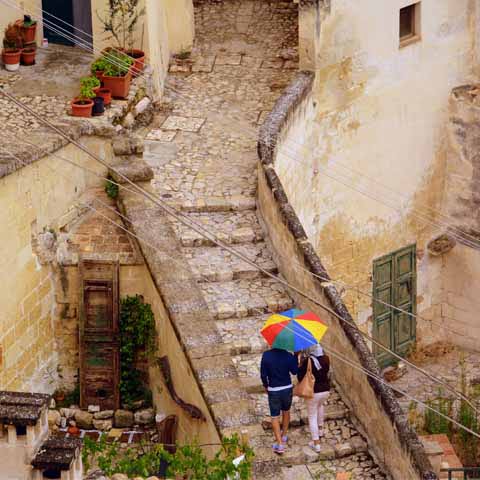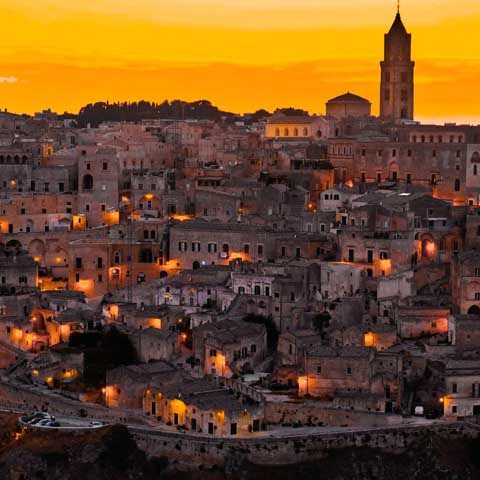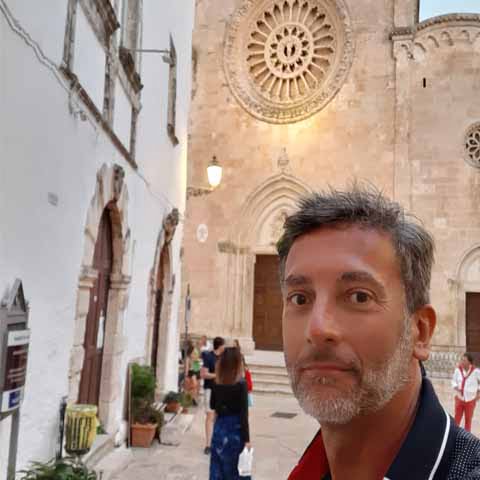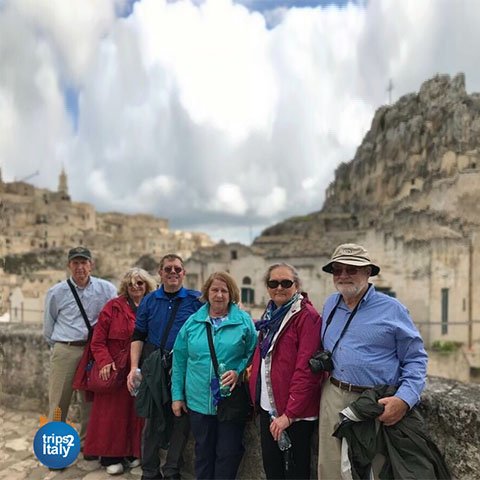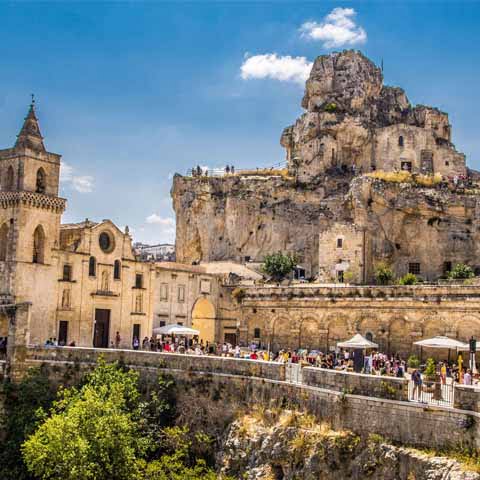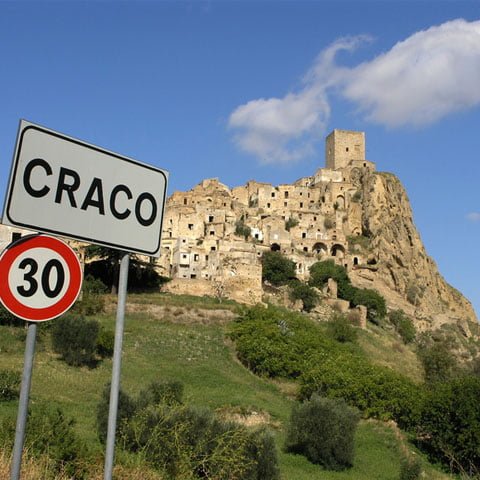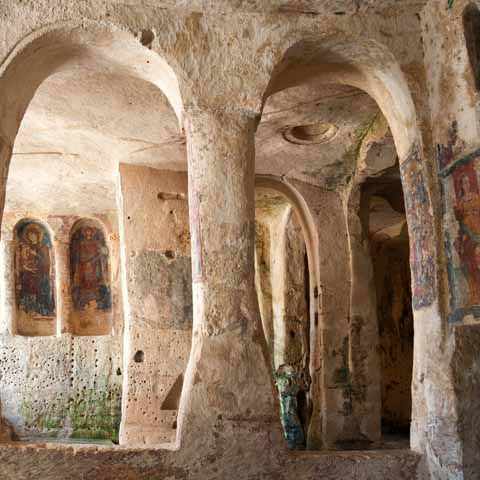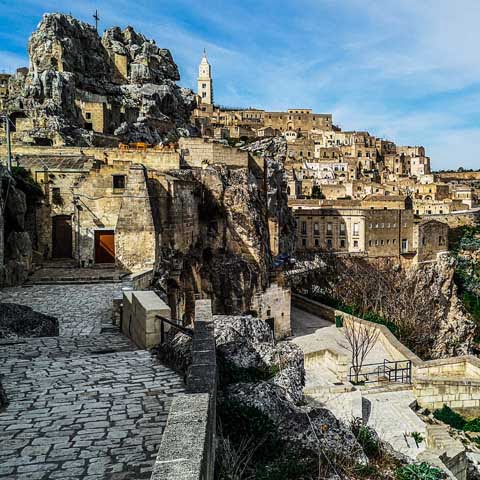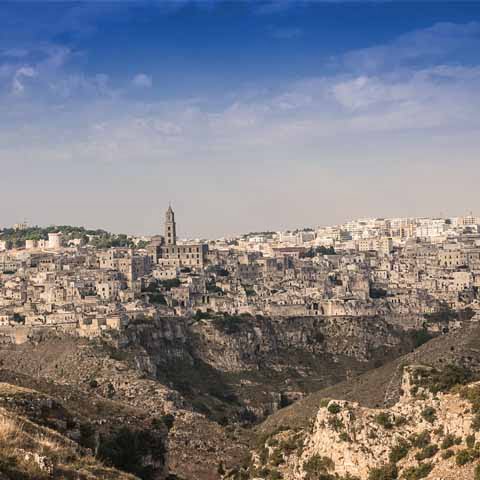Things to do in Basilicata
Some say the joys of Italy are best found by wandering the streets of the most popular cities in the world, but in doing so one misses the romance and mysteries of the Italian countryside regions like Basilicata.
Located at the southern end of Italy, Basilicata is home to acres of breathtaking, untamed nature found throughout the Apennine Mountains, and not one, but two coasts. The dining experiences are unparalleled with unique homemade pasta and bread indigenous to the area, not to be outdone by homemade Italian almond and chocolate cookies such as Scorzette. A family atmosphere and the warm people only add to the charm of the region that is best explored with a spirit of adventure.
Festival & Events
The towns of Basilicata are noteworthy for their unique traditions and festivals, which mix history and legends.
Held annually in Barile on Good Friday, a local parade acts out the Stations of the Cross and pays homage to the Passion of Christ. Performers parade through the village’s streets in traditional costumes, inviting the crowd to pray and contemplate the events leading up to Christ’s crucifixion. It is the highlight of the Easter holiday for locals and tourists alike.
The Procession of The Turks, Parata dei Turchi, takes place annually in Potenza on May 29th. According to legend, one May a band of pirates sailed in on the Basenta River and attacked the city of Potenza. Unable to properly defend themselves, the citizens of Potenza asked Bishop Gerardo La Porta for help. The future saint invoked heavenly angels, which pushed away the pirates and liberated the city. Though many believe this to be a historic event, there does not seem to be any basis for this tale in Potenza’s historical record.
Another intriguing tradition is Maggio di San Giuliano, which is held in the village of Accettura starting on Pentecost Sunday. The festival, known as “the wedding of the trees”, is one of the most impressive and well-documented tree rituals in the Mediterranean area. During this 3-day celebration, a female and a male tree are cut in the woods outside the village and then brought to the main square. There they are erected as a single monument that symbolizes the renewing of the natural world through fertility and harvest. The ritual has religious notes as a Christian festival dedicated to Saint Julian as well as Pagan origins.
The Matera Patronal Feast Maria SS della Bruna is the most important feast for residents of Matera. It is celebrated every July 2 and is held in honor of Madonna della Bruna, the town’s patron saint. At five in the morning, a procession of shepherds with the picture of the Virgin begins to wind throughout the city announced by several small explosions. Hours later, the statue of the Madonna is carried by an ornate papier-mâché float in procession from the Church of St. Francis of Assisi to the parish of Piccianello. The Patronal Fest ends late at night with bright and colorful fireworks that illuminate the Gravina and the Sassi of Matera.
Outdoor activities in Basilicata
The Vulture Lakes area, featuring the Laghi di Monticchio, is on many nature lovers’ sightseeing lists. A big and small lake sit atop the craters of an ancient, extinct volcano and are surrounded by natural wonders such as water lilies and a unique type of fauna called Acanthobrahmaea, a moth that is native to the area. The lakes are surrounded by winding paths perfect for hikers and explorers that yearn to experience the feeling of being completely immersed in breathtaking views of nature. Not to be missed is the famous Abbey of San Michele Arcangelo which overlooks both lakes and offers a fantastic view of the entire crater.
The “lunar” landscape of the Lucanian Dolomites, called Dolomiti Lucane, can be admired in the Gallipoli Cognato Piccole Dolomiti Lucane Regional Park located in the heart of Basilicata. As a result of the craggy and sharp peaks, the Dolomiti Lucane are likened in appearance to the Dolomites in northern Italy. The medieval villages of Pietrapertosa and Castelmezzano sit perched on the top of these mountains like amphitheaters tucked into the rocky walls. Because of their locations, the villages offer tourists an ideal spot for bird-watching as the inaccessible rock face provides shelter to many birds of prey. The area is also an attraction sought out by rock climbers, zipliners, and mountain bike enthusiasts.
Shopping
Lining the streets of Basilicata you will find several stores and workshops that offer a vast array of traditional majolica glazed pottery, woodwork, and musical instruments. Unique pottery can be found specifically in Grottole, Venosa, and Melfi where glasses, pitchers, plates, and vases are all created using diverse and distinctive techniques.
Some of the area’s best furniture workshops can be found in Avigliano, San Giorgio Lucano, and Pietrapertosa. But a special mention goes to the city of Matera where crafting ebony and terracotta are a crucial part of traditional culture.
In Terranova del Pollino and San Paolo Albanese, tourists will find a string of unique workshops dedicated to making musical instruments such as bagpipes, tambourines, and more. Viggiano, a small town in the province of Potenza, is highly regarded for its long-standing musical traditions, local musicians, and the production of various musical instruments, most notably the harp.
Activities for Kids
Every young child is enthralled with the grandeur of castles and the stories that go with them. Especially if traveling with little children, be sure to visit the Castle of Melfi that sits atop rolling green hills. The structure is one of the most important castles in southern Italy as it was built in a strategic location that still serves as a gateway between Campania and Apulia. Children, and yes even some adults, dreaming of what it’s like to reign over their own kingdom need only to step outside the castle to take in the sprawling views of the towns and area hugging the foot of the castle’s perch. Every person who enters the castle is struck with the majesty of it all and can go home with an epic story of their own.
Family Activities
Pietragalla is a small village perched on a hill in Basilicata that offers a unique and peculiar atmosphere to its visitors. Worth visiting is the Palmenti Park, which features exceptional historic forms of rock-cut architecture that actively simulate a fairy-tale atmosphere. Made of stone and arranged on different levels, the rocks formations inspire great curiosity. Additionally, in this area visitors will also find caves that were built around 1300 and equipped with tanks cut into the tufa rock for processing and fermenting grapes. The mysterious rock forms, caves, and more can make Palmenti’s visitors easily imagine they have entered a gnome village.
Group Activities
A hamlet of Basilicata, Venosa, offers stunning rock architecture infused with ancient history. One of the more popular spots in Venosa is the unfinished Abbey of the Santissima Trinità, an expansive set of rock structures comprised of spectacular pillars and extravagant archways nestled among the green grass. Also popular for their splendid architecture are the centuries-old structures of Palazzo Calvino, Palazzo del Balì, Palazzo Dardes, Palazzo Lauridia, and Palazzo Rapolla.
Campomaggiore Vecchia, a town that was abandoned in the 19th century following a landslide, is irresistible to those craving the mystical. While there are other ghost towns in the region, Campomaggiore Vecchia is characterized as having an enchanting quality that makes it a unique background for operas, musicals, and concerts.
Unique Experiences in Basilicata
The town of Craco can be found in the hills above the Lucananian Appennines halfway between the mountains and the sea. If traveling between Matera and the Pollino National Park, make the ghost town of Craco a stop on your itinerary. The town was home to more than 1,800 inhabitants that were forced to abandon their homes due to recurring earthquakes and landslides. Their swift exit left the town largely untouched, givingg the appearance of a place where time stands still.
As mentioned, the Sassi di Matera in the Civita district are the oldest and highest group of buildings that dominate and divide the two Sassi areas into Sasso Barisano and Sasso Caveoso. The district is undergoing renovations that stay true to the area’s historical architecture. In the newer area of The Sassi, the stunning Cathedral of Matera sits upon a hill and remains the primary social and religious reference point still today.
On the Tyrrhenian Coastline in the southwest area of Basilicata, lies Maratea, a chic coastal town with a charming historic center, elegant harbor, and pebbled coves. Here the landscape is the true attraction, with everything from breathtaking beaches to heavily wooded hillsides and grand mountains sweeping down into the blue sea. The more than nineteen miles of coastline are home to twenty white sandy beaches and the occasional sea cave. One popular sea cave, La Grotta delle Meraviglie is the only one accessible by foot. High above the coast sits an inspiring white Statue of Christ the Redeemer which is said by locals to watch over the towns below. Hikers and climbers can scale Monte San Biagio where the 72-foot religious statue faces inland, with outstretched arms.
A flight through the Lucanian Dolomites may be just the experience for those that like to do their exploring with both their feet off the ground. The Volo dell’ Angelo, or Flight of the Angel, is among the tallest and longest ziplines in the world, suspended from a mile-long steel cable more than 1,300 feet above the ground. Zipliners can travel speeds of 75 miles per hour as they fly from one point to another in a sturdy body harness. This extreme sport uses the first zipline of its kind in Italy. The visitor’s first flight on the cable is known as “San Martino” and begins in Pietrapertosa at an altitude of 3,300 feet and ends at Castelmezzano at 2,800 feet. After landing, riders can walk amongst the houses of the ancient village, dine at local eateries, and enjoy the view with both feet firmly on the ground before taking a shuttle bus back for a second flight called “Peschiera.”
Basilicata is truly a land with something for everyone, young and old, thrill seeker and sightseer, modern and traditional. No trip to Italy is complete without venturing to southern Italy to take in the charm of Basilicata and its people.
Travel Guides
